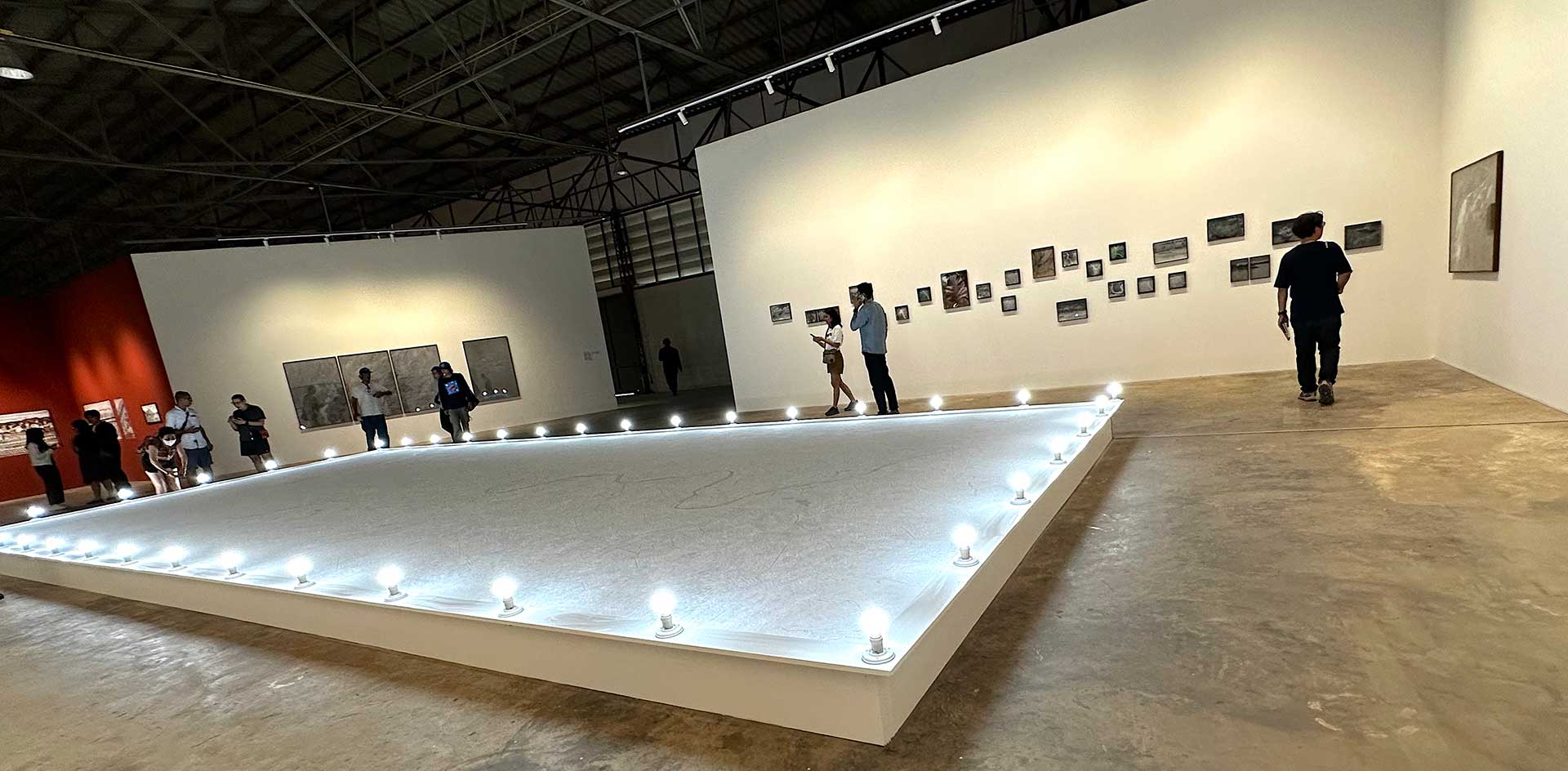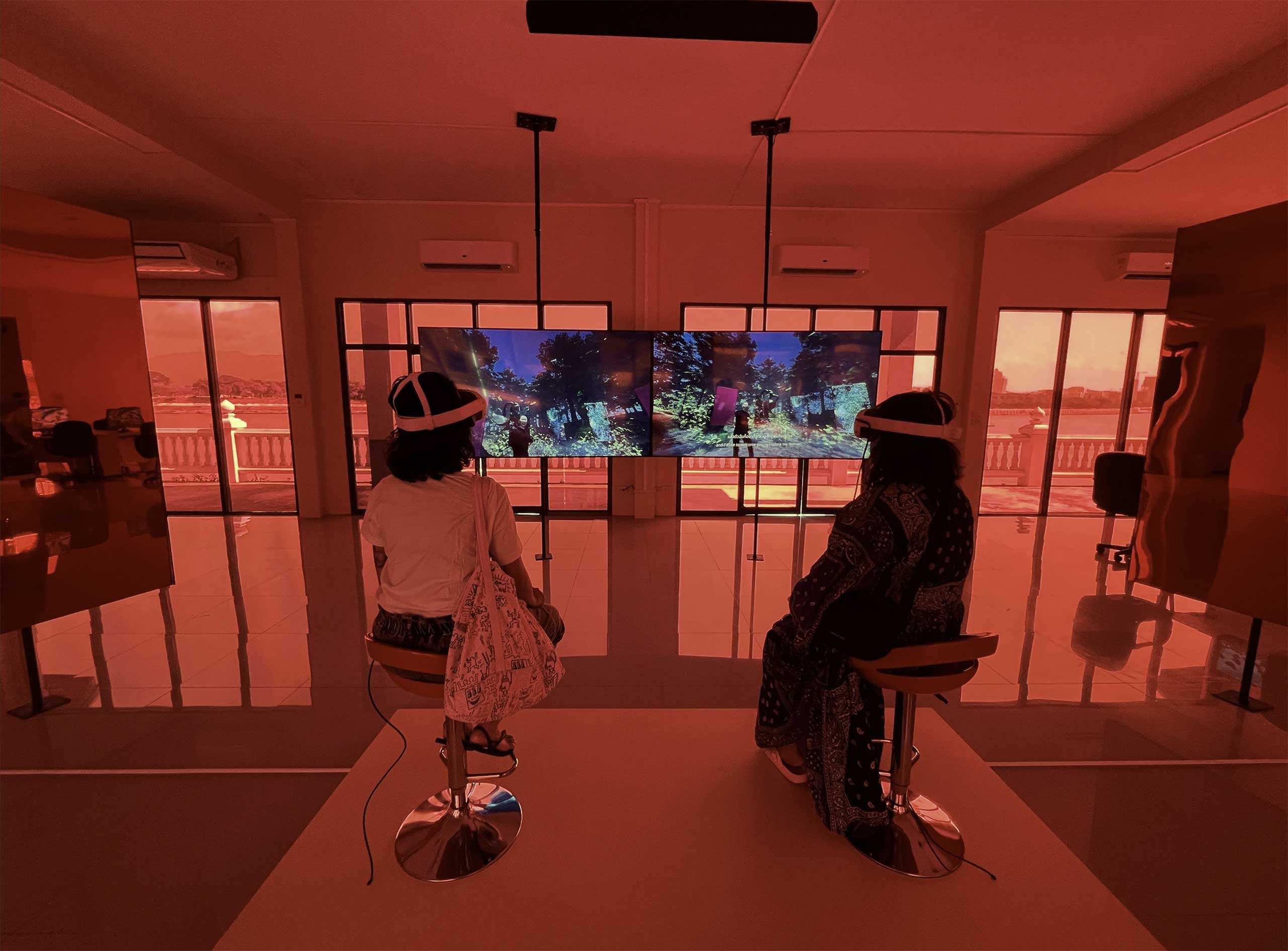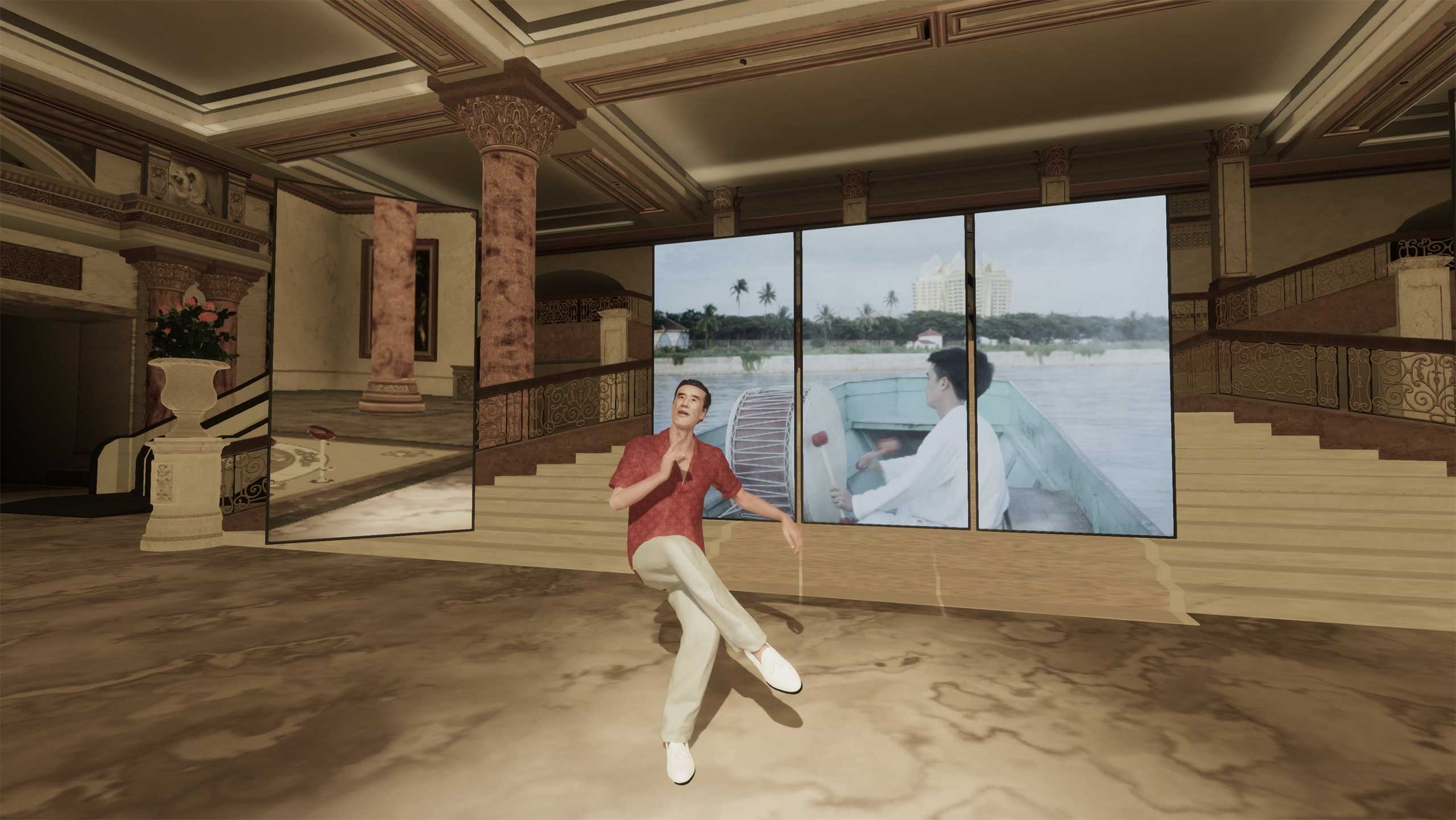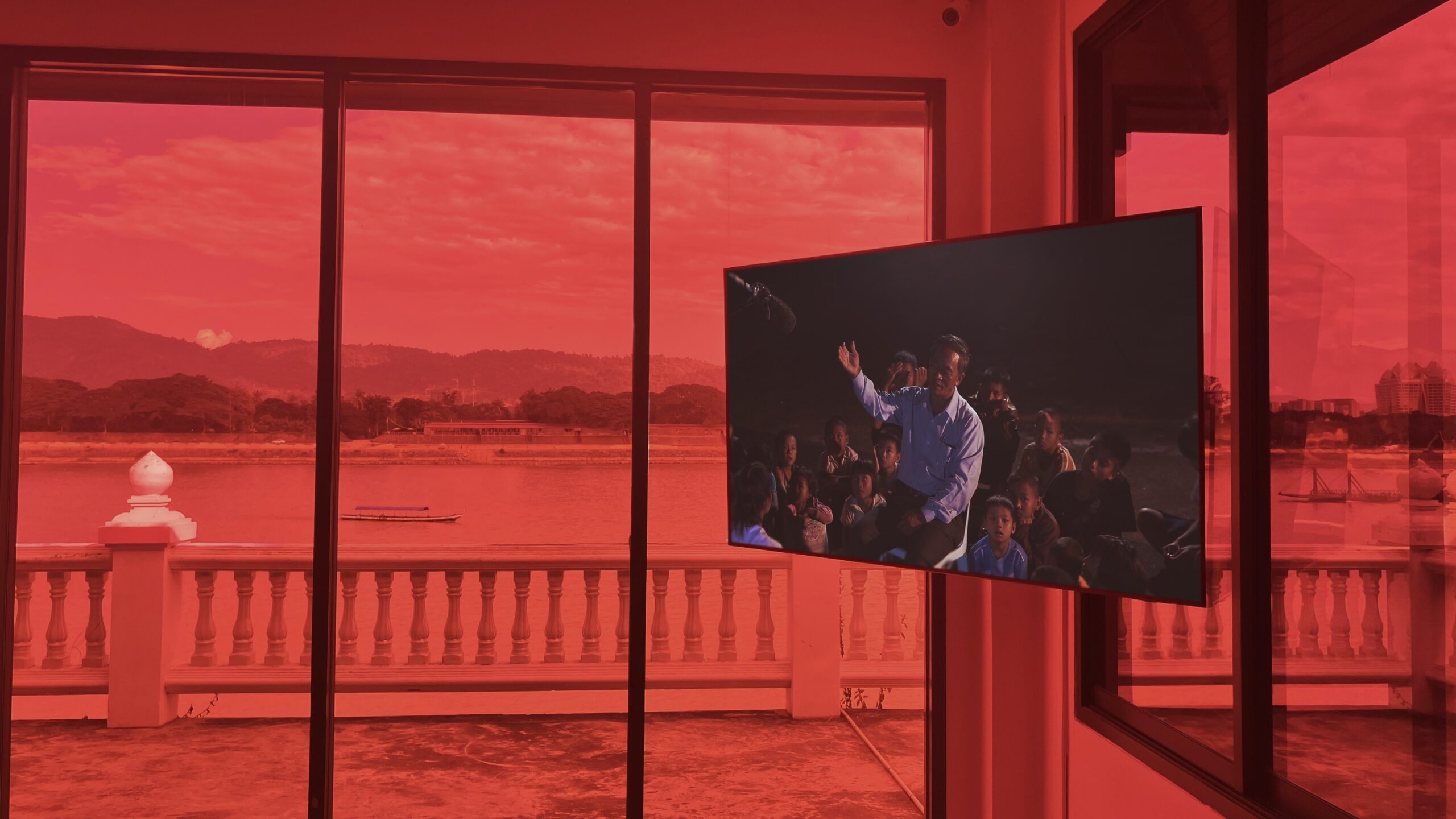本體認識論的繁盛倫理
引言
在一個寒冷的傍晚,在參觀了清萊府的國際當代藝術節,即眾所周知的「2023清萊雙年展(泰國雙年展Thailand Biennale, Chiang Rai 2023)」之後,我便開始在湄公河畔撰寫這篇藝術紀事。這次藝術節得到了各類組織和藝術家的支持與合作,包含政府機構、私部門、國際知名和當地著名的藝術家和策展人等,他們都懷抱著將清萊推動成為「藝術之城」的目標。「雙年展」一詞在泰國被理解為「藝術界每兩年舉辦一次的國際藝術展」。泰國經歷的第一場雙年展是 1895 年的威尼斯雙年展,然而,在眾多歷史背景的調查下,倘若細細來看那屆雙年展的輝煌盛況,許多爭議便會被揭示,包括美學維度下殖民權力的展示、帝國主義的藝術力量,還有來自工業革命後西方世界面臨的結構性變化。
從這個角度來看,藝術節不僅僅是展示美和促進觀光,事實上它也涉及了「政治的美學化」,擁有掩蓋事物的政治特質,並在美學框架下創造一種新的感知模式。政治與美學之間的關係關鍵性地形塑了我們對現實的理解,以及我們在社會中的定位,這也就是所謂的美學政治。
因此,泰國對於「雙年展」模式的採用顯得特別有趣,當然,這並非是藝術界的古老傳統,更重要的是去探討「將藝術建立成為泰國國家文化基石的過程」有何意義?尤其是當以空間、歷史和政治背景等多重向度,考慮在此範圍出現的當代藝術之意涵時,我們會發現所有的因子都緊密地交織且相互牽動。
泰國藝術與威權主義
有關泰國威權主義的研究已經發展了數十年,並有廣泛開展,尤其對政治結構的變遷以及政治領袖的作用之政治和歷史學研究。1 相較之下,與這類議題相關的藝術史研究卻顯少在學術界被提及。然而這類藝術研究的關注其實是非常深入且有趣的,尤其是關乎泰國藝術家的社會角色,探究他們如何透過創作過程誘發大眾向體制提問。新加坡國立大學學者鄭大衛(David Teh)和清邁大學學者塔斯奈・塞塔瑟里(Thasnai Sethaseree) 有趣地提出,泰國藝術界在90 年代經歷了一場「本土」與「全球」之間的巨大張力。泰國藝術家開始將文化和傳統思想融入他們的創作理念,顯示了他們對全球化和現代化趨勢的意識和質疑。鄭大衛認為,這類作品表層是本土與全球之間的對立,然而,在更深層次上,則標示著泰國藝術家已與全球藝術有著緊密聯繫,同時又以民族主義為核心反對全球化。在那個時代,最突出、最具代表性的藝術節是「清邁社會裝置」藝術節(Chiang Mai Social Installation)」,它在泰國首都之外創建了一個藝術中心。2 然而,泰國藝術家的民族主義理念就像一顆種子,在藝術進展的身體中生根茁壯。民族主義與全球化之間看似矛盾的關係讓我們明白:一方面,藝術中的民族主義讓藝術生態系統更受資本主義所驅動,原因是藝術家有更多機會與全球藝術界連結以獲得更多展出,進而提高作品銷售;另一方面,藝術中的民族主義並沒有引導對自由的想像,反而推動了許多著名藝術家對政變和專制的認同,尤其是2013年至2014年間的「藝術小巷(Art Lane)」藝術運動,旨在支持由軍方建立以君主為國家元首的絕對民主制度,藉此來消滅「邪惡資本主義」和「專制民主」,而這與泰國的主流民族主義意識形態為一致。
在我看來,90 年代泰國藝術讓人聯想到民族主義意識形態的輝煌,是個悲傷的事實,雖然它最終沒能發揮出應有的潛能,無法在當代繼續存在下去。它的地位就像一座藝術廢墟,等待專制政權來鞏固。因此,它存在於一種美學與政治的對峙中,並與泰國藝術創作的自由息息相關。
自泰國政變後,藝術節與專制政權的共生和相互依賴變得更為明顯。國際當代藝術節「泰國雙年展(The Thailand Biennale)」2018 年於甲米(Krabi)首次舉辦,以及 2021 年於甲呵叻府(Nakhon Ratchasima)舉辦。這兩屆的主辦方均為隸屬於泰國文化部的當代藝術與文化部門(Office of Contemporary Art and Culture),當時由總理巴育・占奧差(Prayut Chan-o-Cha)領導的軍政府執掌。正因如此,泰國雙年展的狀態一直是人們爭論不休的話題,尤其是關於藝術表達的自由程度、融入政治權力機制的論述、專制主義合法性等問題。因此,強調創造性和美學的藝術,已與軍事官僚和行政管理形成共存關係。此外,泰國雙年展已成為全球藝術界的重要聯繫紐帶,時常可見與國際知名策展人和藝術總監的合作,這樣的操作可以看成是專制政權將注意力轉向軟實力的新措舉,為軍政府塑造了現代和當代的形象。
泰國的當代藝術在獨裁政權的庇護下,彷彿恢復到昔日的光輝就足以證明這一點。 一方面,政府各種形式的支持為泰國藝術家提供了更多在國際舞台上曝光的機會,讓泰國藝術呈現前所未有的活躍;然而,另一方面,緊張的政治氛圍、《褻瀆法》(第 112 條)以及對言論自由的限制,則為反映社會政治議題的藝術創作樹立了障礙。許多泰國藝術家選擇將藝術作為爭取民主和自由的途徑,他們利用表演藝術、塗鴉、劇場和音樂等各種藝術形式,來傳達政治訊息並挑戰專制。
在泰國,問「什麼是藝術?」可能不如「藝術能怎麼被應用?」來的那樣重要,更別說還要問「這些藝術由誰資助?」,或是「藝術到底被哪種類型的意識形態給合法化了?」。倘若我們閉上眼睛,仔細回想泰國雙年展展出的各種作品,我們也許會發現,藝術是想向觀眾的思想和生活傳遞知性的愉悅,舉例而言,可以透過視覺引發想像味覺上的愉悅。誠然,這也包括發現能以藝術和文化旅遊作為契機,來刺激新的觀光經濟。然而,我們還能想像其他不在國家支持和認可下,卻依然發揮作用的藝術嗎?那些出現在街頭而非藝術節的普通人和非藝術家的作品;直接挑戰權威的藝術作品;不具複雜學術卻具有知識愉悅的作品等。而上述這些缺少名氣、被逮捕藝術家的作品,在泰國社會的美學想像中究竟處於什麼樣位置?研究上述提問的泰國學者不佔多數,少數幾個如唐娜維・恰卜瑞蒂(Thanavi Chotpradit)對泰國當代藝術受到審查的研究,這種情況正是在過去十年間發生了幾次政變後出現的3;還有研究泰國社運人士和藝術家,對抗由普拉育・占奧差(Prayut Chan-o-cha)將軍領導的軍事政府專制,特別是對「冒犯君主」罪名的抗爭4;另外還有彭迪特・占洛查納吉特(Pandit Chanrochanakit)的關注,他著重於評論過去十年間支持政變的泰國90年代先鋒派藝術家5;包括最近過世的學者塔諾姆.查帕克迪(Thanom Chapakdee,1958 – 2022),他在建立一種不僅抵抗權威也促進的民主化的思維和藝術行動的線路上,扮演了非常重要的角色。
在泰國社會裡,藝術是脆弱而危險的,因為藝術可以透過美學過程壓抑和阻止觀眾對社會的質疑,這是將藝術作品納入專制政權,使政權本身得以合法化,同時助長了特定美學框架的形成,這種政治局勢決定了哪些藝術作品該受到起訴。
政治動盪下游走於邊境的國際當代藝術
2023 年於清萊府舉辦的第三屆泰國雙年展,在與前兩屆完全不同的政治背景下啟動,尤其是2022 年泰國大選後的社會氛圍,泰國公民懷抱希望且努力在各個層面尋求變革。選舉前後所出現的「希望的政治(politics of hope)」 在其中可說是發揮了重要的作用,給予許多民眾勇氣來表達自己的觀點和政治主張。同時,在經歷了長期的專制統治之後,保守派的焦慮情緒也不斷增加。2022 年 5 月 14 日,由巴育・占奧差將軍領導的軍政黨在大選中敗北,然而,不幸的是,獲得最多選票的前進黨(Move Forward Party,พรรคกลาวไกล)無法順利組成政府,因此由排名第二的為泰黨(Pheu Thai Party,พรรคเพือไทย)在前獨裁政權的政治人物加入的情況下成功組建了新政府。處在這種政治動盪中,清萊雙年展卻做了一件令人欽佩的事情:將藝術作為一般人民表達聲音的途徑,讓這些聲音得以在這場雙年展中被顯現出來。
我有幸多次與清萊雙年展的藝術總監格里蒂亞·加威翁(Gridthiya Gaweewong)會面交談。她一再強調,表達平凡人的聲音對於塑造國家歷史、促進權利與平等在泰國社會中的實現至關重要,特別是來自次等群體和在泰國歷史中被忽視的人群。她解釋,她選擇與清萊府合作的主要原因是清萊作為一個邊境城市的獨特地位。這些邊境城市著連接湄公河次區域國家,是融合不同民族和經濟政治力量的複雜交匯。邊境城市還有著許多跨境移民和他們離散的故事,同時也因為他們抵抗國家權威而被知曉。此外,清萊府邊境地區長期以來因「金三角(Golden Triangle)」的形象為人所知,這裡充滿了與毒品和泰國國家安全有關的故事。因此,透過藝術作品展現底層人民的故事,是創造希望政治的重要路徑之一。
尼潘·奧拉尼韋斯納(Nipan Oranniwesna)在清萊雙年展中以「沉默痕跡(Silence Traces)」為主題的作品是一個很好的例子,它引導觀眾探索泰國國家權力機制和製圖技術。他在作品中運用多種地圖作為主要元素和敘事方式。第一張地圖是清萊邊境地區的軍事地圖,最古老的地圖可追溯至1936年,一直使用到1967年,這張地圖是當代藝術和文化辦公室(Office of Contemporary Art and Culture)提供的副本以供展示;第二張地圖則是一張覆蓋整個清萊省的空拍照片,提供觀眾存取和下載;最後一張地圖則是置放在大廳中央的藝術裝置,尼潘將從網路上下載的清萊省五個地區的地圖列印出來,挖空地圖上的其他元素,只留下道路和河流,再讓藝術家們從於地圖上方撒下白色粉末,覆蓋被剪去的空白區域,粉末堆甚至變成了畫布上的風景。尼潘的作品不僅讓我們對空間和國界有了更深入的理解,也使人透過眼睛感知到軍事影像的技術。這個視角是從國家安全的技術出發,為觀眾提供了在當下重新思索過去維度的時刻,並為觀眾開啟了與國家敘事對話的體驗。尼潘的作品不僅在表面留下痕跡,更在個人與集體記憶、以及國家所創造的記憶之間留下了視覺辯證的印跡。

1 Thak Chaloemtiarana, Thailand: The Politics of despotic paternalism (SEAP Publicationl, 2007).; Soren Ivarsson and Lotte Isager, “Saying the Unsayable: Monarchy and Democracy in Thailand,” in NIAS Studies in Asian Topics (NIAS Press, 2010); Nattapoll Chaiching, “The Monarchy and the Royalist Movement in Modern Thai Politics, 1932 – 1957,” in Saying the Unsayable: Monarchy and Democracy in Thailand, ed. Soren Ivarsson and Lotte Isager, (NIAS Studies in Asian Topics, NIAS Press,2010).
2 David Teh, Thai Art: Currencies of the Contemporary (The MIT Press:2017).; David Teh and other authors, Artist-to-Artist: Independent Art Festivals in Chiang Mai 1992–98 (Afterall Books 與亞洲藝術檔案館(Asia Art Archive)和巴德學院策展研究中心(the Center for Curatorial Studies, Bard College)共同出版: 2018).; Thasnai Sethaseree “The Po-Mo Artistic Movement in Thailand: Overlapping Tactics and Practices,” Asian Culture and History Vol.3, No. 1: 31-45.
3 Thanavi Chotpradit, “Of Art and absurdity: military, censorship, and contemporary art in Thailand,” Journal of Asia-Pacific pop culture Vol.3, No.1 (2018): 5-25.
4 Thanavi Chotpradit, “SHATTERING GLASS CEILING,” in The Routledge Companion to Art and Activism in the Twenty-First Century, ed. Lesley Shipley and Mey-Yen Moriuchi (eds Taylor & Francis: 2022).
5 Pandit Chanrochanakit, “Deforming Thai Politics: As read through Thai Contemporary Art,” Third Text Vol. 25. No. 4 (2011): 419-429.; Pandit Chanrochanakit, “Reluctant Avant-Garde: Politics and Art in Thailand” Obieg Magazine (2016).
若說尼潘的作品是企圖對國家所設計之空間的解構和質疑,那麼《斯拉欽館:打開賈·普羅明的世界(Sla Khin Pavilion: Opening J. Prommin’s World)》的策展人潘迪特・查羅查納基特(Pandit Chanrochanakit)則採取了相反的操作。具體來說,這涉及到展出清萊藝術賈姆魯斯・普羅明(Jamrus Prommin,1934-1999)的風景畫。賈姆魯斯透過工業繪畫開創出自身作品的獨特性,從表層看,他的作品也許並不突出,也沒有呈現出複雜的創作過程,然而若深入觀察,他的一系列畫作就像是對清萊省風景的探索和紀錄的過程。賈姆魯斯的作品類似於民族誌繪畫,旨在透過圖片詳細描述一般人的生活。不同之處在於,賈姆魯斯不是一位專注研究其他社會的民族誌學者,他的藝術透過旅行和訓練有素的雙眼記錄了家鄉人民的故事,講述的故事補充了航空照片和軍事地圖所無法呈現的。考慮到這一點,《斯拉欽館:打開賈·普羅明的世界》非常成功地讓平凡人關於自己家園和領土的故事,在觀賞的瞬間觸發一系列記憶而宛在目前。在學術界,我們理解並接受:現代國家主權控制了人們的生活,以及民族主義意識形態是被繪製出來的。6 然而,潘迪特的策展擁有帶領觀眾質疑大寫的地理身體(Geo-body。大寫G)的潛力,正因為大寫的地理身體指的是透過地圖和軍事技術等權力所創造,再填補經緯度交會所造成的缺口而形成。而相對的則是小寫的地理身體(geo-boby,小寫g),是根據一般人的觀點和視角,以及人們的生活經驗重新想像繪製而成。

當然,對於藝術家和策展人而言,清萊的邊界和探索領域都極具挑戰。邊界這個空間同時有著生命與逝去,也是一直承載著國家與在地之間權力關係的場域。在一個貼滿紅色膠片的展間,台灣藝術家許家維的作品以紀錄短片的形式播放,《一位來自金三角的演員(The Actor from Golden Triangle)》將人們的經驗、該地區的歷史維度和金三角地區巧妙地交織在一起。《回莫村(Huai Mo Village)》影片中訪問了一位曾在金三角地區工作的中情局特工,他有著不堪回首的過去,這位前間諜曾被邊境上頗具影響力的毒梟坤沙(Khun Sa) 擄獲並施以酷刑。許家維以藝術家的角色,接近了一些因父母涉毒而變成孤兒的孩子們,教導他們紀錄片的拍攝技巧,這些孤兒即是被影片中的男子收養。紀錄片講述的故事,宛如平靜湄公河水面下洶湧的波濤,而紅色暗房的氛圍,似乎在暗示著金三角不安和異常的狀態。在這個邊界地帶,許家維的創作意味著讓一個被壓抑的、緊閉的、只能存在於之間空間的敘事,走向了公共議題的範圍。他的作品是試圖道出現代國家史學中被遺忘的群體故事。



什麼是希望政治? 這個問題在泰國的政治騷動中經常浮現。「希望」這個問題,一直是圍繞在「一個普通人是否真能創造希望」的存疑。在社運人士和藝術實踐家仍面臨被起訴和關進審訊室的情況下,清萊雙年展展出的藝術作品即是希望存在的證明,質疑和削弱了用以控制和支配人民的國家權力之合法性。
藝術是寓含希望的關鍵信息。
美學治理與解放美學
上述藝術作品只是清萊雙年展的部分參展作品。清萊雙年展的藝術家和創作過程多元,無法一概而論此為泰國最佳的雙年展。然而,經過這次觀展,我不斷反思,清萊雙年展是否與泰國 「民族主義藝術進步(Nationalistic Artistic Progress) 」的氛圍有顯著不同。當然,造成這種差異的關鍵條件在於美學的政治地位,一個不再被用來控制或管理人們的美學狀態。這使我想起了賈克・洪席耶(Jacques Rancière)的重要主張,他是法國著名的哲學家和理論家,因其對美學、政治學和批判理論的貢獻而聞名於世。7 他對美學與政治之間的關係提出了獨特的見解,挑戰了傳統對藝術的態度,並對美學經驗提出了徹底的反思。在本案例中,洪席耶的美學思想可以用兩個要點來描述。首先,他強調 「審美平等(aesthetic equality)」的概念,認為每個人皆有經驗美和參與藝術的能力,反對將美學視為專家或特權菁英專屬領域的傳統觀念,他認為,美學本質上具有民主的品質,無論其社會或文化背景,任何人都能夠經驗美學。其次,他討論了「異識(dissensus)」和「美學政治(Politics of Aesthetics)」,認為藝術擁有政治維度,並且可以透過打破既有的等級制度和權力結構來挑戰現有秩序。
清萊雙年展的美學經驗對新可能性抱持敞開,以美學平等作為核心,鼓勵每位觀眾用自己的方式和風格接近藝術。然而,作為一個旁觀者,我注意到不斷有一股勢力試圖介入藝術詮釋的過程。特別是扭曲和調整藝術的意涵,使其與佛教的解釋相一致,包括清萊府的著名僧侶試圖將藝術納入佛教的世界觀,或者可以稱之為「藝術的佛教化」。他們認為佛教代表泰國文化且地位崇高,可以藉此提升藝術品的價值並賦予更大的意義。這種觀點對平等意識構成了極大的挑戰,並在形塑美學中的權力關係起了關鍵作用。因此,清萊雙年展變成美學的競爭平台,強調藝術家的特殊地位和作品的不同意涵,各群體也在其中極力維護藝術的價值。該次活動也同樣包含了創造解放美學的過程,以及相信每個人都有平等的接近藝術的潛力。
我還記得一次與著名電影導演和編劇阿彼察邦・韋拉斯哈古(Apichatpong Weerasethakul)的訪談,談論關於在人工智慧參與創作過程漸增、挑戰人類作為創作者角色的背景下,對於藝術地位的看法。對於這個問題,阿彼察邦認為藝術是一種智性的愉悅,這有助於擴大對藝術的認知範圍,並就世界萬物之間的關係展開一系列的討論,而不必堅持藝術必須完全由人類創造的原則。8 這次訪談的重要意義在於將藝術視為智性的愉悅,這似乎是在各種脈絡下的一種廣泛而包容的回應。當然,激發批判性思考和刺激智力是創作過程中關鍵的一環。然而,更值深思的是,智性的愉悅是如何透過展覽、活動和藝術節將權力結構和不公滲入社會中。這些活動都是在國家的贊助下進行,而國家透過選擇性的推廣藝術家和藝術作品,以便將這些作品作為感知世界以及理解個體在社會體系中位置的主要途徑。因此,阿彼察邦的觀點需要進一步的解釋和謹慎的詮釋。在我看來,如果藝術能夠引領人們踏上沉思的生活(vita contemplativa),從而恢復人類積極生存的狀態(vita activa),那麼它就具有巨大的價值。如今,當代藝術可以將人類從根深蒂固的信仰中解放出來,它也有助於讓「沈思之旅」成為創造變革和顛覆傳統思想結構的一部分。
基於上述被視為重要的智性的愉悅,我們不能忽略或無視藝術美學經驗中的平等概念。 平等是一項根本原則,無論社會地位、文化或背景,每個人都能同等地擁有和欣賞藝術。這意味著,在美學體驗中平等是優先考量,這不僅關乎創作者和觀眾之間的關係,這個理想也確保每個人都可以平等地參與藝術,以尋求知識和情感的交融。在現今社會和生活條件下,創造一個具有包容性的環境,以及提供每個人體驗藝術的機會至關重要。 因此,在此背景下考慮智性的愉悅時,必須意識到平等、無歧視地參與美學的重要性,這也攸關到為每個人創造平等地參與在感知藝術和創造藝術的機會。
結語:朝向民主的藝術想像
我在清邁大學美術學院的工作區寫下了這篇藝術紀事的結語。幾天后,我親愛的同事、我的學生和我將不得不面對一場法律訴訟,我們被指控涉嫌佔據學校的藝術中心,僅僅是因為企圖將其打造為一個可以展示任何類型藝術的公共場域。 2021至2022 年,許多校內學生的作品遭到審查,並受到於大學藝術中心展出的限制。 部分學生也面臨了根據第 112 條款的法律訴訟,因他們的藝術行動訴說了泰國社會中「不能說」的議題。然而,若藝術不是為無聲者發聲,或藝術並非試圖為社會觀念和意識結構帶來重塑,那麼藝術的力量何在?
清萊雙年展讓我體認到藝術創作的民主本質,我也從諸多作品中汲取了靈感。 透過藝術過程普通人和無聲者的聲音得以顯現,同時也達到尊重多元、尊重差異意見以及意識到表達的權利和自由。我立刻明白,在政府意圖體制化藝術並將其作為治理工具的背景下,先前提到作品卻實對國家的思想結構提出了尖銳的批判。現在是發展一個真正民主、不受國家干涉的雙年展之時刻了。是時候讓大眾自行組織藝術節,並讓自由成為一種有機審美,一種人們自出生便擁有、且被視為天賦權利的有機美學。
美學平等的戰場可以存在,且具體存在於世上的每個角落。
7 Jacques Rancière, The Politics of Aesthetics: The Distribution of the Sensible (New York/London: Continuum, 2004).
8 Pimchanok Puksuk, “A Conversation with Apichatpong,” 2024 at The 101 World 7 February, https://www.the101.world/a-conversation-with-apichatpong/?fbclid=IwAR2S4o9HpdTo_WA-LpegcB79YI5ckaF3aguVMbSBLIyYhYQPISf9SjnEr70
1 Thak Chaloemtiarana, Thailand: The Politics of despotic paternalism (SEAP Publicationl, 2007).; Soren Ivarsson and Lotte Isager, “Saying the Unsayable: Monarchy and Democracy in Thailand,” in NIAS Studies in Asian Topics (NIAS Press, 2010); Nattapoll Chaiching, “The Monarchy and the Royalist Movement in Modern Thai Politics, 1932 – 1957,” in Saying the Unsayable: Monarchy and Democracy in Thailand, ed. Soren Ivarsson and Lotte Isager, (NIAS Studies in Asian Topics, NIAS Press,2010).
2 David Teh, Thai Art: Currencies of the Contemporary (The MIT Press:2017).; David Teh and other authors, Artist-to-Artist: Independent Art Festivals in Chiang Mai 1992–98 (Afterall Books 與亞洲藝術檔案館(Asia Art Archive)和巴德學院策展研究中心(the Center for Curatorial Studies, Bard College)共同出版: 2018).; Thasnai Sethaseree“The Po-Mo Artistic Movement in Thailand: Overlapping Tactics and Practices,”Asian Culture and History Vol.3, No. 1: 31-45.
3 Thanavi Chotpradit, “Of Art and absurdity: military, censorship, and contemporary art in Thailand,” Journal of Asia-Pacific pop culture Vol.3, No.1 (2018): 5-25.
4 Thanavi Chotpradit, “SHATTERING GLASS CEILING,” in The Routledge Companion to Art and Activism in the Twenty-First Century, ed. Lesley Shipley and Mey-Yen Moriuchi (eds Taylor & Francis: 2022).
5 Pandit Chanrochanakit, “Deforming Thai Politics: As read through Thai Contemporary Art,” Third Text Vol. 25. No. 4 (2011): 419-429.; Pandit Chanrochanakit, “Reluctant Avant-Garde: Politics and Art in Thailand” Obieg Magazine (2016).
6 Winichakul, 1997.
7 Jacques Rancière, The Politics of Aesthetics: The Distribution of the Sensible (New York/London: Continuum, 2004).
8 Pimchanok Puksuk, “A Conversation with Apichatpong,” 2024 at The 101 World 7 February, https://www.the101.world/a-conversation-with-apichatpong/?fbclid=IwAR2S4o9HpdTo_WA-LpegcB79YI5ckaF3aguVMbSBLIyYhYQPISf9SjnEr70
分享
索拉育·艾姆·烏亞育特(Sorayut Aiem-UeaYut) 是清邁大學視覺與設計文化部門的媒體、藝術與設計系講師,也是博士候選人。他的研究興趣包括藝術人類學、感官政治、物導向存有學和技術轉向。擁有清邁大學和法政大學(Thammasat University)人類學學士和碩士學位,接受攝影訓練並在泰國南部和馬來半島的人和物中進行深入實地考察。他目前的研究聚焦於在馬來西亞吉隆坡生活和工作的泰米爾(Tamil)移民勞工的(非)視覺性。他曾在語言和文化機構(Institute of Language and Cultural Studies)中擔任民族攝影師,並提供研究員攝影培訓。




